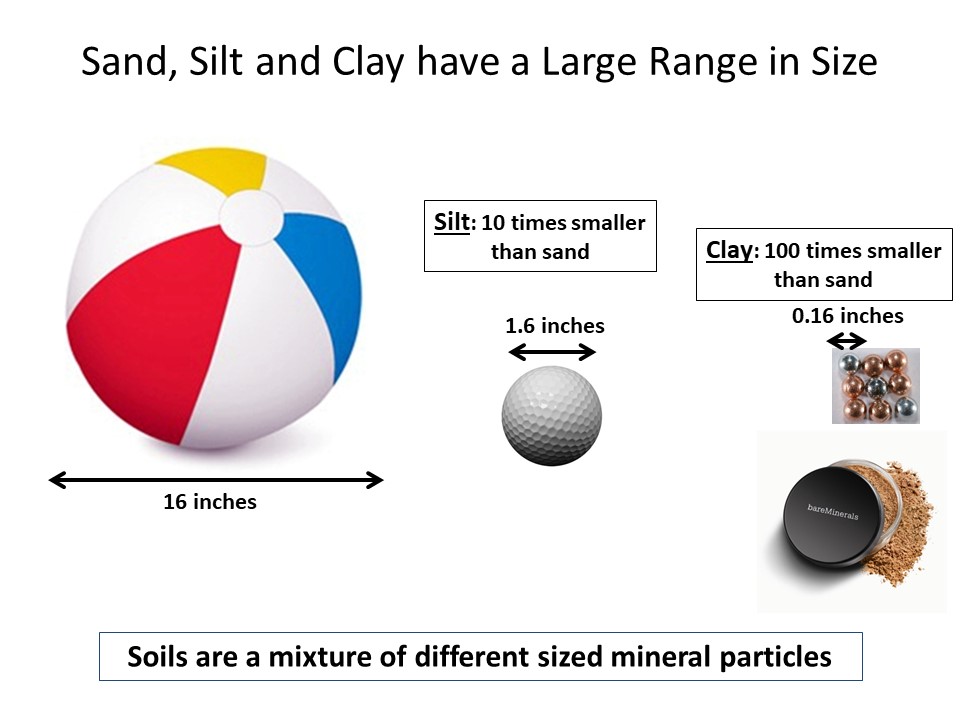What is Soil Texture?

Comparison of relative soil particle sizes. Image credit: Francisco Arriaga, University of Wisconsin
The particle size distribution and relative proportion of sand, silt and clay in the mineral component of soils. The percentage of sand, silt, and clay can affect available water capacity, compaction, structure, bulk density, and porosity as well as other non-physical soil properties.Do you have an excellent resource that isn’t listed here? Submit it for consideration.
| Title | Source | Resource type and date | Short Summary |
|---|---|---|---|
| Soil Health Demonstration: Soil Texture | Soil Health Nexus | How-to Video and Lesson Plan
May 2019 |
Leslie Johnson from University of Nebraska Extension talks about an activity to explain soil texture and water infiltration.Lesson Plan |
| Soil Physical Properties Fact Sheet | North Dakota State University | Extension Factsheet
Not Dated |
Soil physical properties affect the behavior of soil and the functional processes required to meet environmental and human needs |
| Guide to Texture by Feel | USDA-NRCS | Government Webpage
Not Dated |
Flow diagram for teaching soil texture by feel. |
| Soil Health Assessments: Grass Soil Pit and Row Crop Soil Pit | Soil Health Nexus | How-to Videos
May 2019 |
Using soil pits can show many properties of soil. In the video above, Gene Campbell with the NRCS assesses a grass soil pit. In the video below, Travis Harper with University of Missouri Extension assesses a row crop soil pit. |
| Soil Health Assessment: Soil Core Test | Soil Health Nexus | How-to Video
May 2019 |
Todd Lorenz with University of Missouri Extension shows how to use a core sampler instead of a soil pit. |
| Youth Soil Quality Lessons and Videos – Using the Soil Textural Triangle | University of Nebraska | Extension Website Not Dated |
The quality of soil depends upon a variety of factors. NRCS has developed Soil Quality Kit Guides, fact sheets and materials for teachers to integrate into their soils curriculum. In addition, a curriculum has been developed to use in the classroom. These materials were created with funds provided by the Nebraska Environmental Trust. YouTube videos supplement these curricula as well. |
| Soil Texture | Purdue Soil Health Education website | How-to Video Sep 2017 |
Dr. John Graveel, Professor of Agronomy at Purdue University covers the basics of soil texture highlighting the soil texture triangle, etc. |
| Title | Source | Resource type and date | Short Summary |
|---|---|---|---|
| Soil texture fact sheet | Cornell University | Extension Factsheet
Dec 2016 |
Defines soil texture, relates to soil function and provides a protocol on how to measure. |
| Soil and Water Relationships | Noble Research Institute | Blog post from an independent research institute
Sep 2001 |
Soil texture and structure greatly influence water infiltration, permeability, and water-holding capacity. Soil porosity refers to the space between soil particles, which consists of various amounts of water and air. Porosity depends on both soil texture and structure. |
| Soil Quality Information | Penn State | Extension Webpage
Aug 2012 |
Healthy soils yield healthy crops, But what is healthy soil and how do we achieve it? |
| Title | Source | Resource type and date | Short Summary |
|---|---|---|---|
| The Effects of Soil Health Management on Soil and Water Relations | USDA-NRCS | Extension Whitepaper
Not Dated |
Soil and water relationships can be described by soil porosity, water infiltration, permeability, and available water capacity |
| Particle Size Analysis for Soil Texture Determination (Hydrometer Method) | Michigan State University, LTER | Protocol
Jul 2008 |
This method quantitatively determines the physical proportions of three sizes of primary soil particles as determined by their settling rates in an aqueous solution using a hydrometer. |
Last reviewed 10/1/19